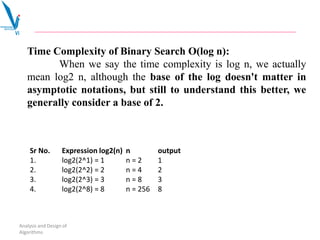Array , Structure and Basic Algorithms.pptx
- 1. Array , Structure and Basic Algorithms UNIT III
- 2. Points to be covered – Concept of Array – Strings – Structures – Algorithms – Complexity
- 3. Introduction to Array • Array is a data structure that represents a collection of the same types of data by a common name. • Compared to the basic data type (int, float & char) it is an aggregate or derived data type. • All the elements of an array occupy a set of contiguous memory locations. • Why need to use array type? Consider the following issue: "We have a list of 1000 students' marks of an integer type. If using the basic data type (int), we will declare something like the following…" int studMark0, studMark1, studMark2, ..., studMark999;
- 4. Arrays • By using an array, we just declare like this, • int studMark[1000]; • This will reserve 1000 contiguous memory locations for storing the students’ marks.
- 5. Declaring Array • When declaring arrays, specify – Type of array – Name – Number of elements arrayType arrayName[ numberOfElements]; – Examples: int c[10]; float myArray[3000]; • Declaring multiple arrays of same type int b[100],x[27];
- 6. Declaring Array For example, to declare an array of 30 characters, that construct a people name, we could declare, char cName[30]; Which can be depicted as follows, In this statement, the array character can store up to 30 characters with the first character occupying location cName[0] and the last character occupying cName[29]. - Note that the index runs from 0 to 29. In C, an index always starts from 0 and ends with array's (size-1).
- 7. Initialization • An array may be initialized at the time of declaration. • Initialization of an array may take the following form, type array_name[size] = {a_list_of_value}; For example: • int idNum[7] = {1, 2, 3, 4, 5, 6, 7}; • float fFloatNum[5] = {5.6, 5.7, 5.8, 5.9, 6.1}; • char chVowel[6] = {'a', 'e', 'i', 'o', 'u', '0'}; • Note the last character in chVowel is NULL character ('0')
- 8. Initialization Example int Ar[10] = {9, 8, 7, 6, 5, 4, 3, 2, 1, 0}; Ar[3] = -1; 8 7 -1 9 Ar 4 3 2 5 1 0 4 5 6 3 0 2 8 9 7 1 8 7 6 9 Ar 4 3 2 5 1 0 4 5 6 3 0 2 8 9 7 1
- 9. Assessing elements • An element is accessed by indexing the array name. • This is done by placing the index of the element within square brackets after the name of the array. Example:- int main() { int i; int a[5]={1,2,3,4,5}; for(i=0;i<5;i++) { printf(“%dt”, a[i]) } }
- 10. Storage Representation • 1-d array are linear array in which elements are stored in the successive memory locations. • The element at the very first position in the array is called its base address. • Suppose name of linear array is arr of type int and it has 5 elements with base address start from 1024. Then it is represented as: offset :- 0 4 8 12 16 index :- 0 1 2 3 4 value:- Address:- 1024 1028 1032 1036 1040 14 46 4 86 23
- 11. Multidimensional array • C programming language allows multidimensional arrays. • The general form of a multidimensional array declaration − type name [size1][size2]… .[sizeN]; • For example, the following declaration creates a two dimensional integer array int twoDimension[5][4];
- 12. Two-dimensional Arrays • The simplest form of multidimensional array is the two-dimensional array. • A two-dimensional array is, in essence, a list of one-dimensional arrays. • Syntax: type arrayName [x][y]; • A two-dimensional array a[3][4], which contains three rows and four columns can be shown as follows-
- 13. Initializing Two-Dimensional Arrays • Multidimensional arrays may be initialized by specifying bracketed values for each row. • Following is an array with 3 rows and each row has 4 columns. • The nested braces, which indicate the intended row, are optional. The following initialization is equivalent to the above example −
- 14. Accessing Two-dimensional array • An element in a two-dimensional array is accessed by using the subscripts, i.e., row index and column index of the array. #include <stdio.h> int main () { /* an array with 5 rows and 2 columns*/ int a[5][2] = { {0,0}, {1,2}, {2,4}, {3,6},{4,8}}; int i, j; /* output each array element's value */ for ( i = 0; i < 5; i++ ) { for ( j = 0; j < 2; j++ ) { printf("a[%d][%d] = %dn", i,j, a[i][j] ); } } return 0; } 0 0 1 2 2 4 3 6 4 8
- 15. Introduction to String • Strings are array of characters i.e. they are characters arranged one after another in memory. Thus, a character array is called string. • Each character in a string occupies one location in an array. • A string is always terminated by a null character (i.e. slash zero 0). VIIT, Pune 15
- 16. Declaration • A string variable is declared as an array of characters. Syntax: char string_name[size]; e.g. char s[5]; • When the compiler assigns a character string to a character array, it automatically supplies a null character (‘0’) at the end of the string VIIT, Pune 16
- 17. Initialization Initialization Syntax: char myString [] = { 'H','A','E','S', 'L', 'E', 'R', '0' } ; char myString[13] = “Initial value” char myString[] = “Initial value”; 0 = null character Note: that ‘0’ and ‘0’ are not same. • When we initialize a character array by listing its elements, the null terminator or the size of the array must be provided explicitly. • When declaring a string don’t forget to leave a space for the null character which is also known as the string terminator character because it is only way the functions that work with a string can know where the string ends. n i t i a l v a l u e ? ? … I 0 Compilation time initialization VIIT, Pune 17
- 18. Differences Between Strings and Character Arrays VIIT, Pune 18
- 19. • Memory for strings must be allocated before the string can be used. • A string literal is enclosed in double quotes VIIT, Pune 19
- 20. Reading String from terminal • Input function scanf can be used with %s format specification to read in a string of characters. • Example: char address[10]; scanf(“%s”, address); • The scanf function automatically terminates the string that is read with a null character. • %ws format specification can be used for reading a specified number of characters from the input string. • scanf with %s or %ws can ready only strings without whitespaces. • C supports a format specification known as the edit set conversion code %[..] that can be used to read a line containing a variety of characters, including whitespaces. • Example: char line[80]; scanf(“%[^n]”,line); VIIT, Pune 20
- 21. Library functions • There are various string handling functions define in string.h some of them are: VIIT, Pune 21
- 22. strlen() • In C, strlen() function calculates the length of string. • It takes only one argument, i.e, string name. Syntax: temp_variable = strlen(string_name); • Function strlen() returns the value of type integer. VIIT, Pune 22
- 23. strcpy() • Function strcpy() copies the content of one string to the content of another string. • Syntax of strcpy() strcpy(destination,source); VIIT, Pune 23
- 24. strcat() • concatenates(joins) two strings. • resultant string is stored in the first string specified in the argument. Syntax of strcat() strcat(first_string,second_string); VIIT, Pune 24
- 25. strcmp() • compares two string and returns value 0, if the two strings are equal. Syntax of strcmp() temp_varaible=strcmp(string1,string2); VIIT, Pune 25
- 27. strlwr() • function converts all the uppercase characters in that string to lowercase characters. • The resultant from strlwr() is stored in the same string. Syntax of strlwr():- strlwr(string_name); VIIT, Pune 27
- 28. strupr() • function converts all the lowercase characters in that string to uppercase characters. • The resultant from strupr() is stored in the same string. Syntax of strupr() strupr(string_name); VIIT, Pune 28
- 29. Structure in C – Introduction to structure • Definition • declaration of structure, declaration of structure variables • initialization, • accessing members of structure • Array of structures Vishwakarma Institute of Information Technology 29
- 30. What is structure • Structure is user defined data type which allows to combine data items of different kinds • Structures are used to represent a record • For example to keep track of books in a library, following attributes about each book has to maintained− – Book ID (Data Type – Int) – Title (Data Type – Char) – Author (Data Type – Char) – Publication (Data Type – Char) – Price (Data Type – Float) Vishwakarma Institute of Information Technology 30
- 31. – Details about individual book such as its Book Id ,Title ,Author, Publication and Price form a single book record BookId Title Author Publication Single Book Record Price Vishwakarma Institute of Information Technology 31
- 32. struct Book { int BookId; char Title[20]; char Author[20]; char Publication[20]; float Price; }; Members OR Fields of Structure struct keyword tag OR structure tag Vishwakarma Institute of Information Technology 32 Defining Structure
- 33. Declaration of structure variable struct Book mybook; OR struct Book { int BookId; char Title[20]; char Author[20]; char Publication[20]; float Price; }mybook; Variable of type Book Variable of type Book Vishwakarma Institute of Information Technology 33
- 34. 0012 C++ Programming Yashwant Kanetkar BPB Publication Single Book Record (Value stored in variable mybook) 235.50 Vishwakarma Institute of Information Technology 34
- 35. Vishwakarma Institute of Information Technology 35
- 36. • To define a structure, struct keyword is used. The struct statement defines a new data type, with more than one member • The structure tag is optional and each member definition is a normal variable definition, such as int i or float f or any other valid variable definition. At the end of the structure's definition, before the final semicolon, you can specify one or more structure variables but it is optional Vishwakarma Institute of Information Technology 36
- 37. Structure Initialization struct Book book1={0012,”C Programming”, ”Yashwant Kanetkar”, ”BPB Publication”, 235.50}; Vishwakarma Institute of Information Technology 37
- 38. Accessing Structure Members • To access any member of a structure, member access operator (.) is used. The member access operator is coded as a period between the structure variable name and the structure member that is to be accessed. Use the keyword struct to define variables of structure type Vishwakarma Institute of Information Technology 38
- 39. Example:- Vishwakarma Institute of Information Technology 39 #include <stdio.h> #include <string.h> struct Book { int BookId; char Title[50]; char Author[50]; char publication[100]; float price; };
- 40. int main( ) { struct Book Book1; /* Declare Book1 of type Book */ struct Book Book2; /* Declare Book2 of type Book */ /* book 1 specification */ Book1.BookId=0012; strcpy( Book1.Title, "C Programming"); strcpy( Book1.Author, "Nuha Ali"); strcpy( Book1.Publication, “BPB Publication"); Book1.Price = 649.50; /* book 2 specification */ Book2.BookId=2314; strcpy( Book2.Title, "Telecom Billing"); strcpy( Book2.Author, "Zara Ali"); strcpy( Book2.Publication, “Prentice Hall"); Book2.Price= 1234.80; return 0; } Vishwakarma Institute of Information Technology 40
- 41. Array of structures #include <stdio.h> #include <string.h> struct Book { int BookId; char Title[20]; char Author[20]; char Publication[20]; float Price; }; int main( ) { struct Book Books[10]; } Vishwakarma Institute of Information Technology 41
- 42. 0012 Computer Organization William Stallings Prentice Hall 980.00 Books[0] 0986 Fundamentals of Digital Circuits A. Anand Kumar PHI Learning 450.00 Books[1] 9876 Database System Concepts Silberschatz, Korth ,Sudarshan Mc Graw Hill 999.00 Books[2] . . . . 8876 Test Your C Skills Yashwant Kanitkar BPB Publications 248.00 Books[9] Vishwakarma Institute of Information Technology 42
- 43. BookId Title Author Publication Price Books[0 ] BookId Title Author Publication Price Books[1 ] BookId Title Author Publication Price Books[2 ] BookId Title Author Publication Price Books[3 ] BookId Title Author Publication Price Books[4 ] BookId Title Author Publication Price Books[5 ] BookId Title Author Publication Price Books[6 ] BookId Title Author Publication Price Books[7 ] BookId Title Author Publication Price Books[8 ] BookId Title Author Publication Price Books[9 ] Vishwakarma Institute of Information Technology 43
- 44. Struct inside another struct Structure 1: struct stud_address { int street; char state[20]; char city[20]; char country[20]; } ; Structure 2: struct stud_data { int stud_id; int stud_age; char stud_name[20]; struct stud_address studentAddress; }; Vishwakarma Institute of Information Technology 44
- 45. struct stu_data mydata = {123, 25, “Chaitanya”, {55,“UP”, “Delhi”, “India”}} Initializing Structure Variable mydata Vishwakarma Institute of Information Technology 45
- 46. • typedef can also be used to give a name to user defined data types . For example, typedef can be used with structure to define a new data type and then use that data type to define structure variables directly as follows − Vishwakarma Institute of Information Technology 46
- 47. #include <stdio.h> #include <string.h> typedef struct Book { int BookId; char Title[20]; char Author[20]; char Publication[20]; float Price; }; Vishwakarma Institute of Information Technology 47
- 48. Vishwakarma Institute of Information Technology 48 #include<stio.h> #include<string.h> int main( ) { Book book; book.BookId=0012; strcpy( book.Title, "C Programming"); strcpy( book.Author, "Nuha Ali"); strcpy( book.Publication, “BPB Publication"); book.Price = 649.50; printf( "Book Id : %dn", book.Book_Id); printf( "Book Title : %sn", book.Title); printf( "Book Author : %sn", book.Author); printf( "Book Publication : %sn", book.Publication); printf( "Book Price : %dn", book.Price); return 0; }
- 49. When the above code is compiled and executed, it produces the following result − Book Id : 0012 Book title : C Programming Book Author : Nuha Ali Book Publication subject : BPB Publication Book Price : 649.50 Vishwakarma Institute of Information Technology 49
- 50. typedef vs #define • #define is a C-directive which is also used to define the aliase for various data types similar to typedef but with the following differences − – typedef is limited to giving symbolic names to types only where as #define can be used to define alias for values as well, e.g. you can define 1 as ONE etc – typedef interpretation is performed by the compiler whereas #define statements are processed by the pre-processor Vishwakarma Institute of Information Technology 50
- 51. #include <stdio.h> #define TRUE 1 #define FALSE 0 int main( ) { printf( "Value of TRUE : %dn", TRUE); printf( "Value of FALSE : %dn", FALSE); return 0; } When the above code is compiled and executed, it produces the following result:- Value of TRUE : 1 Value of FALSE : 0 Vishwakarma Institute of Information Technology 51
- 52. Analysis and Design of Algorithms Searching Algorithm is an algorithm made up of a series of instructions that retrieves information stored within some data structure, or calculated in the search space of a problem domain.
- 53. Linear Search is a method for finding a target value within a list. It sequentially checks each element of the list for the target value until a match is found or until all the elements have been searched. Analysis and Design of Algorithms
- 54. Algorithm: Step1: Start from the leftmost element of array and one by one compare x with each element of array. Step2: If x matches with an element, return the index. Step3: If x doesn’t match with any of elements, return -1. Analysis and Design of Algorithms
- 55. Assume the following Array: Search for 9 Analysis and Design of Algorithms 8 12 5 9 2
- 56. Compare Analysis and Design of Algorithms X= 9 i 8 12 5 9 2
- 57. Compare Analysis and Design of Algorithms X= 9 i 8 12 5 9 2
- 58. Compare Analysis and Design of Algorithms X= 9 i 8 12 5 9 2
- 59. Compare Analysis and Design of Algorithms X= 9 i 8 12 5 9 2
- 60. Found at index = 3 Analysis and Design of Algorithms 8 12 5 9 2
- 61. Time Complexity: O(n) Analysis and Design of Algorithms Example of worst case: search for the last element 4 6 8 9 1
- 62. #include <stdio.h> int main() { int array[100], search, c, n; printf("Enter the number of elements in arrayn"); scanf("%d", &n); printf("Enter %d integer(s)n", n); for (c = 0; c < n; c++) scanf("%d", &array[c]); printf("Enter a number to searchn"); scanf("%d", &search); for (c = 0; c < n; c++)
- 63. Binary Search is the most popular Search algorithm. It is efficient and also one of the most commonly used techniques that is used to solve problems. Binary search use sorted array by repeatedly dividing the search interval in half. Analysis and Design of Algorithms
- 64. Algorithm: Step1: Compare x with the middle element. Step2: If x matches with middle element, we return the mid index. Step3: Else If x is greater than the mid element, search on right half. Step4: Else If x is smaller than the mid element. search on left half. Analysis and Design of Algorithms
- 65. Assume the following Array: Search for 40 Analysis and Design of Algorithms 2 3 10 30 40 50 70
- 66. Compare Analysis and Design of Algorithms X = L R mi d 40 2 3 10 30 40 50 70
- 67. Compare Analysis and Design of Algorithms X = L R mi d 40 2 3 10 30 40 50 70
- 68. Compare Analysis and Design of Algorithms X = L mi d R 40 2 3 10 30 40 50 70
- 69. x=40 , found at index = 4 Analysis and Design of Algorithms 2 3 10 30 40 50 70
- 70. Time Complexity: O(log2 n) Analysis and Design of Algorithms
- 71. #include <stdio.h> int main() { int c, first, last, middle, n, search, array[100]; printf("Enter number of elementsn"); scanf("%d",&n); printf("Enter %d integersn", n); for (c = 0; c < n; c++) scanf("%d",&array[c]); printf("Enter value to findn"); scanf("%d", &search); first = 0; last = n - 1; middle = (first+last)/2; while (first <= last) { if (array[middle] < search)
- 72. first = middle + 1; else if (array[middle] == search) { printf("%d found at location %d.n", search, middle+1); break; } else last = middle - 1; middle = (first + last)/2; } if (first > last) printf("Not found! %d isn't present in the list.n", search); return 0; }
- 73. Analysis and Design of Algorithms
- 74. Analysis and Design of Algorithms Sorting Algorithms: Sorting — arranging items in order — is the most fundamental task in computation. Types of sorting: 1. Selection sort 2. Bubble sort ( slowest algorithm) 3. Insertion sort 4. Merge sort 5. Quick sort (fastest algorithm) 6. Heap sort 7. Radix sort
- 75. Analysis and Design of Algorithms Selection sort is to repetitively pick up the smallest element and put it into the right position • Find the smallest element, and put it to the first position. • Find the next smallest element, and put it to the second position. • Repeat until all elements are in the right positions.
- 77. Analysis and Design of Algorithms The following tracks the code on an array with elements {38, 27, 43, 3, 9, 82, 10}.
- 78. Analysis and Design of Algorithms Disadvantage: • Running time depends only slightly on the amount of order in the file
- 79. #include <stdio.h> int main() { int array[100], n, c, d, position, swap; printf("Enter number of elementsn"); scanf("%d", &n); printf("Enter %d integersn", n); for ( c = 0 ; c < n ; c++ ) scanf("%d", &array[c]); for ( c = 0 ; c < ( n - 1 ) ; c++ ) { position = c; for ( d = c + 1 ; d < n ; d++ ) {
- 80. if ( array[position] > array[d] ) position = d; } if ( position != c ) { swap = array[c]; array[c] = array[position]; array[position] = swap; } } printf("Sorted list in ascending order:n"); for ( c = 0 ; c < n ; c++ ) printf("%dn", array[c]); return 0;
- 81. Bubble Sort: Bubble sort repetitively compares adjacent pairs of elements and swaps if necessary. • Scan the array, swapping adjacent pair of elements if they are not in relative order. This bubbles up the largest element to the end. • Scan the array again, bubbling up the second largest element. • Repeat until all elements are in order.
- 82. The following tracks the code on an array with elements {38, 27, 43, 3, 9, 82, 10} for three rounds of bubbling.
- 84. #include <stdio.h> int main() { int array[100], n, c, d, swap; printf("Enter number of elementsn"); scanf("%d", &n); printf("Enter %d integersn", n); for (c = 0; c < n; c++) scanf("%d", &array[c]); for (c = 0 ; c < n - 1; c++) { for (d = 0 ; d < n - c - 1; d++) {
- 85. if (array[d] > array[d+1]) /* For decreasing order use < */ { swap = array[d]; array[d] = array[d+1]; array[d+1] = swap; } } } printf("Sorted list in ascending order:n"); for (c = 0; c < n; c++) printf("%dn", array[c]); return 0; }
- 86. Analysis and Design of Algorithms Insertion sort maintains a sorted sub-array, and repetitively inserts new elements into it. The process is as following: • Take the first element as a sorted sub-array. • Insert the second element into the sorted sub-array (shift elements if needed). • Insert the third element into the sorted sub-array. • Repeat until all elements are inserted.
- 87. Analysis and Design of Algorithms The following tracks the code on an array with elements {38, 27, 43, 3, 9, 82, 10}.
- 88. Analysis and Design of Algorithms To insert 12, we need to make room for it by moving first 36 and then 24.
- 91. Analysis and Design of Algorithms
- 92. Analysis and Design of Algorithms
- 93. #include <stdio.h> int main() { int n, array[1000], c, d, t; printf("Enter number of elementsn"); scanf("%d", &n); printf("Enter %d integersn", n); for (c = 0; c < n; c++) { scanf("%d", &array[c]); } for (c = 1 ; c <= n - 1; c++) { d = c;
- 94. while ( d > 0 && array[d-1] > array[d]) { t = array[d]; array[d] = array[d-1]; array[d-1] = t; d--; } } printf("Sorted list in ascending order:n"); for (c = 0; c <= n - 1; c++) { printf("%dn", array[c]); } return 0; }
- 95. Analysis and Design of Algorithms Advantages Good running time for “almost sorted” arrays (n) Disadvantages (n2) running time in worst and average case n2/2 comparisons and exchanges
- 96. Analysis and Design of Algorithms How to analyze program? • The analysis of the program does not mean simply working of the program but to check whether for all possible situations programs works or not. •The analysis involves working of the program efficiently. • Efficiency in the sense: The program requires less amount of storage space. The program get executed in very less amount of time. For three different cases of the time complexity. 1. Big-Oh OR Oh notation denoted as ‘O’. 2. Omega notation denoted as ‘Ω’. 3. Theta notation denoted as ‘Ө’.
- 97. Time Complexity: Time required for execution of the program cannot computed in the terms of Seconds because if the following factor: 1. Hardware of the machine. 2. Amount of time required by each machine instruction. 3. Amount of the time required by the compiler to execute the instruction. 4. Instruction set. Hence we assume that time required by the program to execute means the total number of times the statements get executed. The number of times the statement executing is known as frequency count
- 98. Analysis and Design of Algorithms Example 1: main() { int i,n,a=1; printf(“|n Enter the value of Number=”); scanf(“%d”,&n); for(i=0;i<n;i++) a=a+5; }
- 99. Analysis and Design of Algorithms Analysis: • Printf() ans scanf() will be executed once • i=0 will executed once. • i<n will executed n times when i is less than n. • i++ will execute n times. • a=a=5 will execute n-1 times. Summarize: • Above steps i.e. 3n+2. • But while denoting its time complexity we consider only the order of magnitude hence we will neglect all the constants and the terms becomes equal to n. Therefore time complexity will be given as O(n).
- 100. Time Complexity of Binary Search O(log n): When we say the time complexity is log n, we actually mean log2 n, although the base of the log doesn't matter in asymptotic notations, but still to understand this better, we generally consider a base of 2. Let's first understand what log2(n) means.
- 101. Sr No. Expression log2(n) n output 1. log2(2^1) = 1 n = 2 1 2. log2(2^2) = 2 n = 4 2 3. log2(2^3) = 3 n = 8 3 4. log2(2^8) = 8 n = 256 8 Analysis and Design of Algorithms Time Complexity of Binary Search O(log n): When we say the time complexity is log n, we actually mean log2 n, although the base of the log doesn't matter in asymptotic notations, but still to understand this better, we generally consider a base of 2.
- 102. Analysis and Design of Algorithms It will be easier for us to relate it with the time complexity of the binary search algorithm and also to understand
- 103. Analysis and Design of Algorithms • Suppose the input array has n elements. • The outer loop runs n-1 rounds, roughly one for each position. • Inside each outer loop, the inner loop goes through the unsorted part of the array. • On average, each inner loop scans through n/2 elements. • The total time is roughly t(n) = (n – 1) * (n/2) *k = O(n^2), where k denotes the number of basic operations inside each inner loop; the constants are absorbed in the big-Oh notion. • Note that in the big-Oh notion, we only care about the dominating factor (which is n^2 in this case).

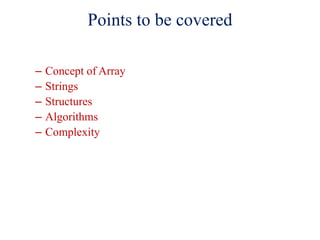

![Arrays
• By using an array, we just declare like this,
• int studMark[1000];
• This will reserve 1000 contiguous memory locations for storing the
students’ marks.](https://image.slidesharecdn.com/arraystructureandbasicalgorithms-240206052831-e01777b4/85/Array-Structure-and-Basic-Algorithms-pptx-4-320.jpg)
![Declaring Array
• When declaring arrays, specify
– Type of array
– Name
– Number of elements
arrayType arrayName[ numberOfElements];
– Examples:
int c[10];
float myArray[3000];
• Declaring multiple arrays of same type
int b[100],x[27];](https://image.slidesharecdn.com/arraystructureandbasicalgorithms-240206052831-e01777b4/85/Array-Structure-and-Basic-Algorithms-pptx-5-320.jpg)
![Declaring Array
For example, to declare an array of 30 characters, that construct a
people name, we could
declare,
char cName[30];
Which can be depicted as follows,
In this statement, the array character can
store up to 30 characters with the first
character occupying location cName[0] and
the last character occupying cName[29].
- Note that the index runs from 0 to 29. In C, an index always starts
from 0 and ends with array's (size-1).](https://image.slidesharecdn.com/arraystructureandbasicalgorithms-240206052831-e01777b4/85/Array-Structure-and-Basic-Algorithms-pptx-6-320.jpg)
![Initialization
• An array may be initialized at the time of declaration.
• Initialization of an array may take the following form,
type array_name[size] = {a_list_of_value};
For example:
• int idNum[7] = {1, 2, 3, 4, 5, 6, 7};
• float fFloatNum[5] = {5.6, 5.7, 5.8, 5.9, 6.1};
• char chVowel[6] = {'a', 'e', 'i', 'o', 'u', '0'};
• Note the last character in chVowel is NULL character ('0')](https://image.slidesharecdn.com/arraystructureandbasicalgorithms-240206052831-e01777b4/85/Array-Structure-and-Basic-Algorithms-pptx-7-320.jpg)
![Initialization Example
int Ar[10] = {9, 8, 7, 6, 5, 4, 3, 2, 1, 0};
Ar[3] = -1;
8 7 -1
9
Ar 4 3 2
5 1 0
4 5 6
3
0 2 8 9
7
1
8 7 6
9
Ar 4 3 2
5 1 0
4 5 6
3
0 2 8 9
7
1](https://image.slidesharecdn.com/arraystructureandbasicalgorithms-240206052831-e01777b4/85/Array-Structure-and-Basic-Algorithms-pptx-8-320.jpg)
![Assessing elements
• An element is accessed by indexing the array name.
• This is done by placing the index of the element within square brackets
after the name of the array.
Example:-
int main()
{
int i;
int a[5]={1,2,3,4,5};
for(i=0;i<5;i++)
{
printf(“%dt”, a[i])
}
}](https://image.slidesharecdn.com/arraystructureandbasicalgorithms-240206052831-e01777b4/85/Array-Structure-and-Basic-Algorithms-pptx-9-320.jpg)

![Multidimensional array
• C programming language allows multidimensional arrays.
• The general form of a multidimensional array declaration −
type name [size1][size2]… .[sizeN];
• For example, the following declaration creates a two
dimensional integer array
int twoDimension[5][4];](https://image.slidesharecdn.com/arraystructureandbasicalgorithms-240206052831-e01777b4/85/Array-Structure-and-Basic-Algorithms-pptx-11-320.jpg)
![Two-dimensional Arrays
• The simplest form of multidimensional array is the two-dimensional array.
• A two-dimensional array is, in essence, a list of one-dimensional arrays.
• Syntax:
type arrayName [x][y];
• A two-dimensional array a[3][4], which contains three rows and four
columns can be shown as follows-](https://image.slidesharecdn.com/arraystructureandbasicalgorithms-240206052831-e01777b4/85/Array-Structure-and-Basic-Algorithms-pptx-12-320.jpg)

![Accessing Two-dimensional array
• An element in a two-dimensional array is accessed by using
the subscripts, i.e., row index and column index of the array.
#include <stdio.h>
int main ()
{
/* an array with 5 rows and 2 columns*/
int a[5][2] = { {0,0}, {1,2}, {2,4}, {3,6},{4,8}};
int i, j;
/* output each array element's value */
for ( i = 0; i < 5; i++ )
{
for ( j = 0; j < 2; j++ )
{
printf("a[%d][%d] = %dn", i,j, a[i][j] );
}
}
return 0;
}
0 0
1 2
2 4
3 6
4 8](https://image.slidesharecdn.com/arraystructureandbasicalgorithms-240206052831-e01777b4/85/Array-Structure-and-Basic-Algorithms-pptx-14-320.jpg)
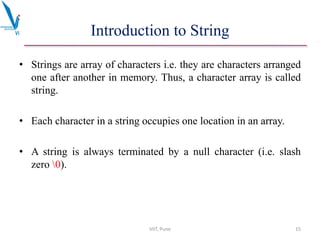
![Declaration
• A string variable is declared as an array of characters.
Syntax:
char string_name[size];
e.g. char s[5];
• When the compiler assigns a character string to a
character array, it automatically supplies a null character
(‘0’) at the end of the string
VIIT, Pune 16](https://image.slidesharecdn.com/arraystructureandbasicalgorithms-240206052831-e01777b4/85/Array-Structure-and-Basic-Algorithms-pptx-16-320.jpg)
![Initialization
Initialization Syntax:
char myString [] = { 'H','A','E','S', 'L', 'E', 'R', '0' } ;
char myString[13] = “Initial value”
char myString[] = “Initial value”;
0 = null character
Note: that ‘0’ and ‘0’ are not same.
• When we initialize a character array by listing its elements, the null
terminator or the size of the array must be provided explicitly.
• When declaring a string don’t forget to leave a space for the null
character which is also known as the string terminator character
because it is only way the functions that work with a string can know
where the string ends.
n i t i a l v a l u e ? ? …
I 0
Compilation time
initialization
VIIT, Pune 17](https://image.slidesharecdn.com/arraystructureandbasicalgorithms-240206052831-e01777b4/85/Array-Structure-and-Basic-Algorithms-pptx-17-320.jpg)


![Reading String from terminal
• Input function scanf can be used with %s format specification to
read in a string of characters.
• Example: char address[10]; scanf(“%s”, address);
• The scanf function automatically terminates the string that is read
with a null character.
• %ws format specification can be used for reading a specified
number of characters from the input string.
• scanf with %s or %ws can ready only strings without whitespaces.
• C supports a format specification known as the edit set conversion
code %[..] that can be used to read a line containing a variety of
characters, including whitespaces.
• Example:
char line[80];
scanf(“%[^n]”,line);
VIIT, Pune 20](https://image.slidesharecdn.com/arraystructureandbasicalgorithms-240206052831-e01777b4/85/Array-Structure-and-Basic-Algorithms-pptx-20-320.jpg)





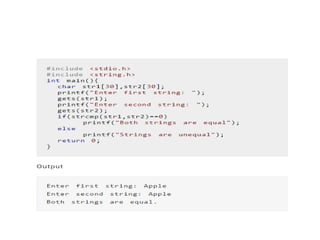

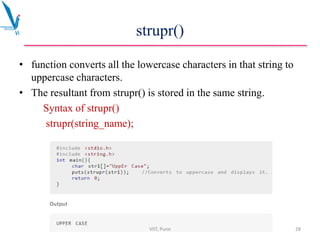


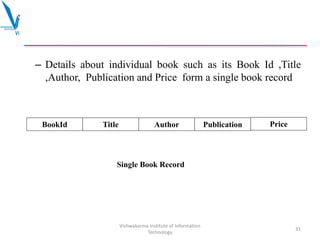
![struct Book
{
int BookId;
char Title[20];
char Author[20];
char Publication[20];
float Price;
};
Members
OR Fields
of Structure
struct
keyword
tag OR structure
tag
Vishwakarma Institute of Information
Technology
32
Defining Structure](https://image.slidesharecdn.com/arraystructureandbasicalgorithms-240206052831-e01777b4/85/Array-Structure-and-Basic-Algorithms-pptx-32-320.jpg)
![Declaration of structure variable
struct Book mybook;
OR
struct Book
{
int BookId;
char Title[20];
char Author[20];
char Publication[20];
float Price;
}mybook;
Variable of type Book
Variable of type Book
Vishwakarma Institute of Information
Technology
33](https://image.slidesharecdn.com/arraystructureandbasicalgorithms-240206052831-e01777b4/85/Array-Structure-and-Basic-Algorithms-pptx-33-320.jpg)





![Example:-
Vishwakarma Institute of Information
Technology
39
#include <stdio.h>
#include <string.h>
struct Book
{
int BookId;
char Title[50];
char Author[50];
char publication[100];
float price;
};](https://image.slidesharecdn.com/arraystructureandbasicalgorithms-240206052831-e01777b4/85/Array-Structure-and-Basic-Algorithms-pptx-39-320.jpg)

![Array of structures
#include <stdio.h>
#include <string.h>
struct Book
{
int BookId;
char Title[20];
char Author[20];
char Publication[20];
float Price;
};
int main( )
{
struct Book Books[10];
}
Vishwakarma Institute of Information
Technology
41](https://image.slidesharecdn.com/arraystructureandbasicalgorithms-240206052831-e01777b4/85/Array-Structure-and-Basic-Algorithms-pptx-41-320.jpg)
![0012
Computer Organization
William Stallings
Prentice Hall
980.00
Books[0]
0986
Fundamentals of Digital Circuits
A. Anand Kumar
PHI Learning
450.00
Books[1]
9876
Database System Concepts
Silberschatz, Korth ,Sudarshan
Mc Graw Hill
999.00
Books[2]
. .
. .
8876
Test Your C Skills
Yashwant Kanitkar
BPB Publications
248.00
Books[9]
Vishwakarma Institute of Information
Technology
42](https://image.slidesharecdn.com/arraystructureandbasicalgorithms-240206052831-e01777b4/85/Array-Structure-and-Basic-Algorithms-pptx-42-320.jpg)
![BookId Title Author Publication Price
Books[0
]
BookId Title Author Publication Price
Books[1
]
BookId Title Author Publication Price
Books[2
]
BookId Title Author Publication Price
Books[3
]
BookId Title Author Publication Price
Books[4
]
BookId Title Author Publication Price
Books[5
]
BookId Title Author Publication Price
Books[6
]
BookId Title Author Publication Price
Books[7
]
BookId Title Author Publication Price
Books[8
]
BookId Title Author Publication Price
Books[9
]
Vishwakarma Institute of Information Technology
43](https://image.slidesharecdn.com/arraystructureandbasicalgorithms-240206052831-e01777b4/85/Array-Structure-and-Basic-Algorithms-pptx-43-320.jpg)
![Struct inside another struct
Structure 1:
struct stud_address
{
int street;
char state[20];
char city[20];
char country[20];
} ;
Structure 2:
struct stud_data
{
int stud_id;
int stud_age;
char stud_name[20];
struct stud_address studentAddress;
};
Vishwakarma Institute of Information
Technology
44](https://image.slidesharecdn.com/arraystructureandbasicalgorithms-240206052831-e01777b4/85/Array-Structure-and-Basic-Algorithms-pptx-44-320.jpg)


![#include <stdio.h>
#include <string.h>
typedef struct Book
{
int BookId;
char Title[20];
char Author[20];
char Publication[20];
float Price;
};
Vishwakarma Institute of Information
Technology
47](https://image.slidesharecdn.com/arraystructureandbasicalgorithms-240206052831-e01777b4/85/Array-Structure-and-Basic-Algorithms-pptx-47-320.jpg)






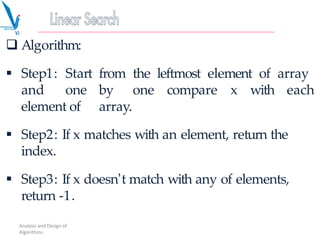


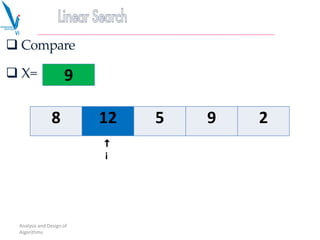


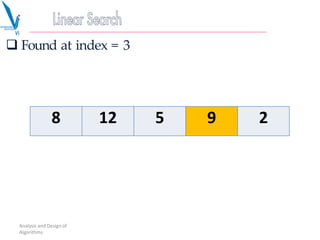

![#include <stdio.h>
int main()
{
int array[100], search, c, n;
printf("Enter the number of elements in arrayn");
scanf("%d", &n);
printf("Enter %d integer(s)n", n);
for (c = 0; c < n; c++)
scanf("%d", &array[c]);
printf("Enter a number to searchn");
scanf("%d", &search);
for (c = 0; c < n; c++)](https://image.slidesharecdn.com/arraystructureandbasicalgorithms-240206052831-e01777b4/85/Array-Structure-and-Basic-Algorithms-pptx-62-320.jpg)
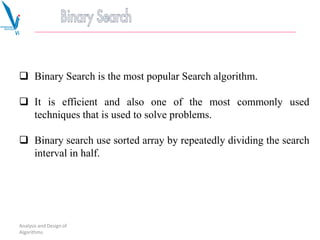

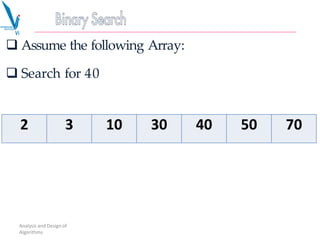





![#include <stdio.h>
int main()
{
int c, first, last, middle, n, search, array[100];
printf("Enter number of elementsn");
scanf("%d",&n);
printf("Enter %d integersn", n);
for (c = 0; c < n; c++)
scanf("%d",&array[c]);
printf("Enter value to findn");
scanf("%d", &search);
first = 0;
last = n - 1;
middle = (first+last)/2;
while (first <= last)
{
if (array[middle] < search)](https://image.slidesharecdn.com/arraystructureandbasicalgorithms-240206052831-e01777b4/85/Array-Structure-and-Basic-Algorithms-pptx-71-320.jpg)
![first = middle + 1;
else if (array[middle] == search)
{
printf("%d found at location %d.n", search, middle+1);
break;
}
else
last = middle - 1;
middle = (first + last)/2;
}
if (first > last)
printf("Not found! %d isn't present in the list.n", search);
return 0;
}](https://image.slidesharecdn.com/arraystructureandbasicalgorithms-240206052831-e01777b4/85/Array-Structure-and-Basic-Algorithms-pptx-72-320.jpg)
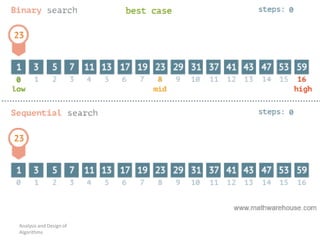
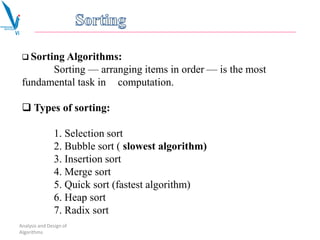




![#include <stdio.h>
int main()
{
int array[100], n, c, d, position, swap;
printf("Enter number of elementsn");
scanf("%d", &n);
printf("Enter %d integersn", n);
for ( c = 0 ; c < n ; c++ )
scanf("%d", &array[c]);
for ( c = 0 ; c < ( n - 1 ) ; c++ )
{
position = c;
for ( d = c + 1 ; d < n ; d++ )
{](https://image.slidesharecdn.com/arraystructureandbasicalgorithms-240206052831-e01777b4/85/Array-Structure-and-Basic-Algorithms-pptx-79-320.jpg)
![if ( array[position] > array[d] ) position = d;
}
if ( position != c )
{
swap = array[c];
array[c] = array[position];
array[position] = swap;
}
}
printf("Sorted list in ascending order:n");
for ( c = 0 ; c < n ; c++ )
printf("%dn", array[c]);
return 0;](https://image.slidesharecdn.com/arraystructureandbasicalgorithms-240206052831-e01777b4/85/Array-Structure-and-Basic-Algorithms-pptx-80-320.jpg)
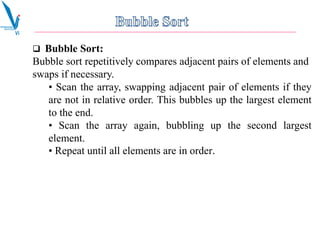


![#include <stdio.h>
int main()
{
int array[100], n, c, d, swap;
printf("Enter number of elementsn");
scanf("%d", &n);
printf("Enter %d integersn", n);
for (c = 0; c < n; c++)
scanf("%d", &array[c]);
for (c = 0 ; c < n - 1; c++)
{
for (d = 0 ; d < n - c - 1; d++)
{](https://image.slidesharecdn.com/arraystructureandbasicalgorithms-240206052831-e01777b4/85/Array-Structure-and-Basic-Algorithms-pptx-84-320.jpg)
![if (array[d] > array[d+1]) /* For decreasing order use < */
{
swap = array[d];
array[d] = array[d+1];
array[d+1] = swap;
}
}
}
printf("Sorted list in ascending order:n");
for (c = 0; c < n; c++)
printf("%dn", array[c]);
return 0;
}](https://image.slidesharecdn.com/arraystructureandbasicalgorithms-240206052831-e01777b4/85/Array-Structure-and-Basic-Algorithms-pptx-85-320.jpg)



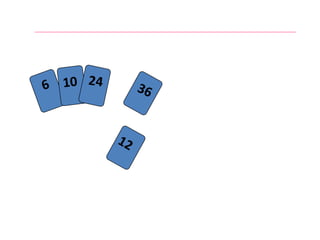
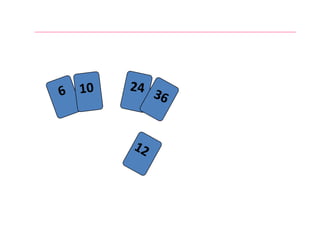


![#include <stdio.h>
int main()
{
int n, array[1000], c, d, t;
printf("Enter number of elementsn");
scanf("%d", &n);
printf("Enter %d integersn", n);
for (c = 0; c < n; c++)
{
scanf("%d", &array[c]);
}
for (c = 1 ; c <= n - 1; c++)
{
d = c;](https://image.slidesharecdn.com/arraystructureandbasicalgorithms-240206052831-e01777b4/85/Array-Structure-and-Basic-Algorithms-pptx-93-320.jpg)
![while ( d > 0 && array[d-1] > array[d])
{
t = array[d];
array[d] = array[d-1];
array[d-1] = t; d--;
}
}
printf("Sorted list in ascending order:n");
for (c = 0; c <= n - 1; c++)
{
printf("%dn", array[c]);
}
return 0;
}](https://image.slidesharecdn.com/arraystructureandbasicalgorithms-240206052831-e01777b4/85/Array-Structure-and-Basic-Algorithms-pptx-94-320.jpg)






